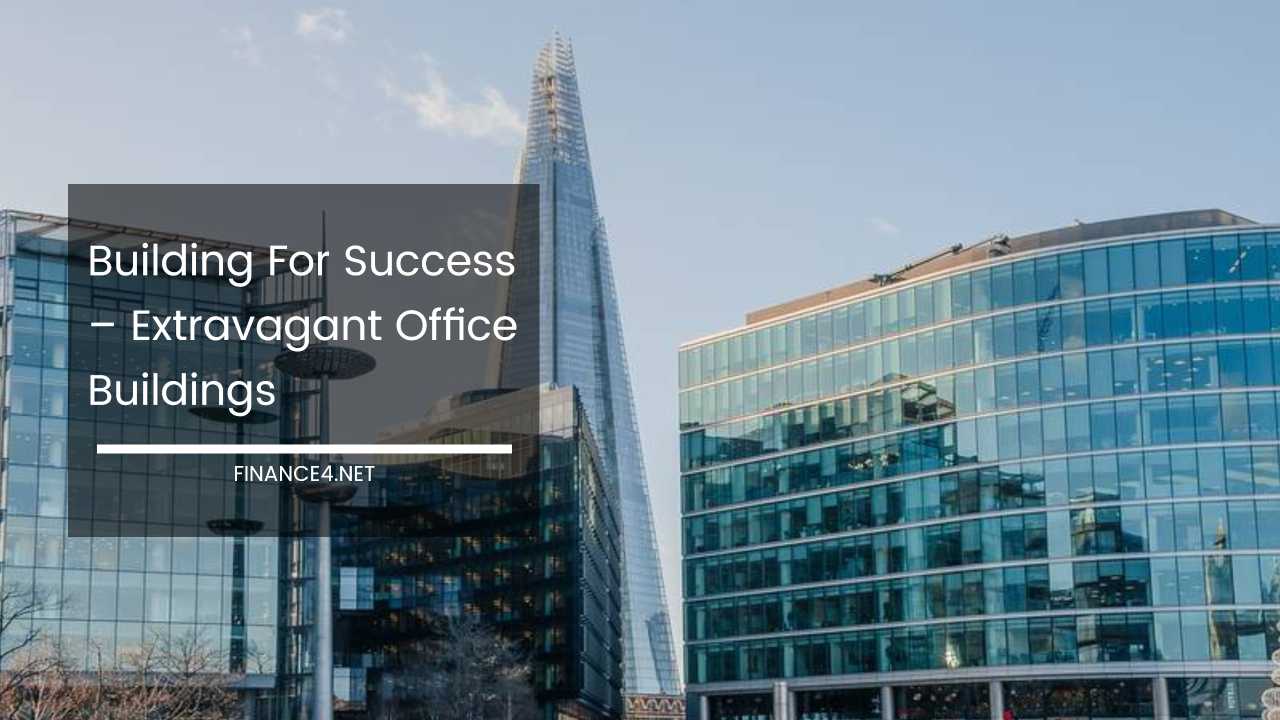Building For Success – Extravagant Office Buildings

Building For Success: Unveiling the World’s Most Extravagant Office Palaces
For most of us, the daily grind takes place within the confines of a typical office building. But for a select few, work unfolds in architectural masterpieces that push the boundaries of design, construction, and sheer extravagance.
These sky-piercing testaments to ambition boast not only jaw-dropping heights and groundbreaking aesthetics, but also price tags that would make your head spin.
Let’s embark on a global journey to explore some of the most opulent office palaces ever built.
London’s Soaring Shard:
The crown jewel of London’s recent architectural renaissance is none other than The Shard. Not only does it snatch the title of tallest building in Western Europe, but it also comes with a hefty price tag, estimated to be around 1.5 billion pounds.
This translates into some of the most exclusive office addresses in the capital. Towering at a staggering 1,016 feet, the Shard’s facade is a marvel of engineering, comprised of thousands upon thousands of glass panels.
This shimmering skin reflects the ever-changing hues of the sky and sunlight, creating a captivating spectacle that transforms with the weather. Imagine working amidst this constantly evolving panorama – a daily dose of inspiration for any creative mind.
Hong Kong’s Iconic X-Factor: The Bank of China Tower.
Across the globe in Hong Kong, the Bank of China Tower stands tall at over 1,000 feet. This billion-dollar behemoth has become a defining landmark of the city’s skyline.
Originally envisioned to house the eponymous bank’s offices, it now offers coveted leasing opportunities to other prestigious organizations. However, the building’s unique design, characterized by its distinctive, interlocking X shapes, has been a source of controversy.
Critics argue that it defies traditional feng shui principles, potentially disrupting the flow of positive energy. Whether superstition or sound structural design prevails, there’s no denying this building’s iconic presence.
China’s Sky-High Efficiency: Shanghai World Financial Center.
Reaching for the clouds at a staggering 1,600 feet, the Shanghai World Financial Center claims its place among the world’s tallest buildings.
This architectural marvel cost a cool 1.2 billion dollars to construct, making it one of China’s most expensive recent projects. However, the impressive price tag reflects more than just aesthetics.
The tower’s innovative design incorporates a trapezoid-shaped aperture, cleverly constructed with steel and reinforced concrete.
This ingenious approach allows for a reduction in overall building materials needed, making it a surprisingly efficient giant.
The building boasts over 100 floors, offering a diverse mix of office spaces, high-end retail outlets, a museum, and even the luxurious Park Hyatt Shanghai hotel. Talk about a one-stop shop for work, play, and everything in between!
Dubai’s Desert Dominator: Burj Khalifa.
Undisputedly the king of the concrete jungle, the Burj Khalifa reigns supreme as the tallest building on the planet, soaring over 2,700 feet into the sky.
This engineering marvel dominates Dubai’s bustling business district and boasts a construction cost that matches its height – a staggering 1.5 billion dollars.
One might expect office space here to come at an equally astronomical price. However, the story takes an unexpected turn. The global economic downturn coincided with the building’s completion, leaving a significant portion of its office space unoccupied.
This slump in demand, coupled with mounting debt, has led to a drastic drop in rental costs. While the initial vision may not have fully materialized, the Burj Khalifa remains a breathtaking testament to human ambition and engineering prowess.
This mixed-use development offers a captivating combination of office space, residential units, sprawling shopping malls, high-end hotels, observation decks, and even a swimming pool suspended hundreds of feet above the ground.
The Burj Khalifa’s intricate structural design and reinforced concrete construction ensure its dominance for years to come.
Taiwan’s Technological Marvel: Taipei 101.
Previously holding the coveted title of world’s tallest building, Taipei 101 continues to awe with its dizzying heights of over 1,600 feet.
This iconic skyscraper boasts more than 100 floors, each offering a unique perspective of the bustling Taiwanese metropolis below.
Built specifically to symbolize the harmonious fusion of cutting-edge technology and time-honored Asian traditions, Taipei 101 is designed to withstand even the most punishing natural disasters, including earthquakes and typhoons.
With a construction cost of a staggering 1.8 billion dollars, this architectural feat is home to a dynamic mix of office spaces, high-end retail outlets, world-class restaurants, and even a state-of-the-art fitness center.
Imagine enjoying a healthy lunch crafted by a Michelin-starred chef, followed by a rejuvenating yoga session overlooking the city skyline, all within the confines of your workday.
Beyond the Big Five: A Glimpse into Other Opulent Office Abodes
Our exploration of the world’s most extravagant office havens wouldn’t be complete without venturing beyond the iconic “Big Five.” Here are a few additional architectural gems that redefine the concept of a workplace:
Apple Park, Cupertino, USA:
Embodying the sleek minimalism synonymous with the Apple brand, Apple Park is more than just an office building; it’s a 175-acre campus designed by the visionary architect, Steve Jobs.
This futuristic donut-shaped complex, nicknamed “the spaceship,” boasts an estimated price tag of $5 billion. Clad in floor-to-ceiling glass panels, the structure seamlessly integrates with the surrounding Californian landscape, blurring the lines between the indoors and outdoors.
Natural light floods the workspaces, fostering a collaborative and inspiring environment for Apple’s creative minds.
Sustainability is a core principle here, with the campus featuring the world’s largest rooftop solar panel installation, further solidifying Apple’s commitment to environmental responsibility.
Antilia, Mumbai, India:
While not strictly an office building, Antilia deserves a mention for its sheer scale and extravagance. This 27-story private residence, belonging to Indian billionaire Mukesh Ambani, boasts an estimated cost of $1 billion.
However, Antilia’s extravagant features – including three helipads, a ballroom, a private movie theater, and a snow room – have led some to consider it a luxurious office-residential hybrid. With a staff exceeding 600, the sheer size and opulence of Antilia redefine the concept of a corporate headquarters.
CCTV Headquarters, Beijing, China:
Nicknamed “The Big Trouser Leg” for its unique shape, the CCTV Headquarters in Beijing is a bold architectural statement.
Designed by Dutch architect Rem Koolhaas, the building consists of two leaning towers that converge at the top, resembling a pair of intertwined pants. This unconventional design houses office spaces for China Central Television, along with a five-star hotel, a museum, and a theater.
The building’s estimated cost of $1.2 billion reflects not only its intricate construction but also its symbolic significance as a landmark of modern China.
The Crystal, London, UK:
Sustainability takes center stage at The Crystal, a strikingly modern office building in London’s Docklands. Designed by the award-winning Siemens company,
The Crystal embodies a commitment to environmental responsibility. The building boasts a self-regulating temperature system, a rainwater harvesting system, and a facade constructed from recycled materials.
This eco-friendly marvel offers office space for various organizations working in the field of sustainability, creating a dynamic hub for green innovation.
The Future of Opulent Offices: Beyond Price Tags
While these extravagant office buildings raise eyebrows with their astronomical costs, the future of opulent offices may lie beyond mere price tags. The focus may shift towards:
Employee Wellness and Wellbeing: Modern workplaces are increasingly prioritizing employee well-being. Expect to see biophilic design principles incorporated, with natural light, greenery, and access to outdoor spaces becoming standard features.
Buildings may also offer amenities like fitness centers, healthy cafeterias, and on-site childcare facilities, fostering a holistic approach to employee health.
Imagine working amidst a cascading indoor waterfall or stepping out onto a rooftop terrace for a rejuvenating break – these features will no longer be a luxury, but an essential element of a truly opulent workspace.
Smart Technology Integration: The integration of smart technologies will redefine the way we work.
Imagine seamless building automation systems that adjust lighting and temperature based on occupancy, voice-activated controls for everything from scheduling meetings to adjusting window blinds, and personalized workspaces that adapt to individual needs – ergonomic chairs that automatically adjust to your posture, monitors that configure to your preferred viewing angle.
Data-driven insights might be used to optimize space utilization, improve energy efficiency, and enhance overall employee productivity.
The opulent office of the future will be an intelligent ecosystem that anticipates and seamlessly fulfills the needs of its occupants.
Collaboration and Social Interaction: As remote work becomes increasingly prevalent, future office spaces may prioritize collaboration and social interaction. Expect to see the rise of flexible workspaces that can be easily reconfigured to accommodate different team sizes and project needs.
Open-plan layouts will likely remain popular, but with designated areas for brainstorming sessions, team meetings, and quiet focus work.
The goal will be to create a vibrant and engaging environment that fosters creativity, knowledge sharing, and a strong sense of community.
Think interactive whiteboards that allow for remote team members to participate seamlessly in brainstorming sessions or relaxation areas designed to encourage spontaneous conversations and idea exchange.
These features will cultivate a sense of belonging and foster a collaborative spirit by creating a vibrant and multifaceted environment that caters to both individual needs and team interaction.
Imagine colleagues bumping into each other in the relaxation area, sparking impromptu brainstorming sessions, or fellow employees connecting over shared interests during yoga classes.
This not only strengthens personal bonds but also encourages knowledge sharing and cross-departmental collaboration.
The Human Touch: Luxury Redefined
The opulent office of the future will likely go beyond just technological advancements and incorporate a renewed focus on the human experience. Here are some potential trends:
Art and Cultural Integration: Art has the power to inspire, stimulate, and elevate our moods. Expect to see office spaces adorned with curated art collections, featuring both established and emerging artists.
Additionally, the integration of cultural experiences, from on-site galleries showcasing rotating exhibits to artist talks and musical performances, could become commonplace.
Imagine working amidst a collection of contemporary sculptures or taking a midday break to catch a live jazz performance – these experiences will enrich the workday and foster a more stimulating environment.
Personalized Touches and Customization: Opulence may no longer be synonymous with uniformity. The future might see office spaces that cater to individual preferences and needs. Imagine ergonomic furniture that can be customized to each employee’s physique, or adjustable lighting systems that allow workers to personalize their workspace illumination.
Biometric sensors could even be used to tailor the temperature and air quality within individual workspaces, creating a truly personalized environment that optimizes comfort and well-being.
A Focus on Local and Sustainable Materials: Sustainability will remain a significant consideration in the design of opulent offices. Expect to see a growing emphasis on using locally sourced, eco-friendly materials in construction and interior design.
This not only reduces the environmental impact but also creates a unique aesthetic that reflects the local landscape and culture.
Imagine working in a space adorned with sustainably harvested wood from nearby forests or furniture crafted from recycled materials – these touches showcase a commitment to environmental responsibility and create a more authentic and regionally inspired work environment.
A Symbiotic Relationship: Beyond the Physical Space
The concept of an opulent office may extend beyond the physical workspace. Companies might prioritize:
Curated Employee Experiences: Opulent workplaces may offer curated employee experiences that extend beyond the office walls. Imagine exclusive discounts on fitness programs, cultural events, or travel opportunities.
Companies might even provide personalized recommendations for restaurants, entertainment options, or wellness activities based on individual preferences.
These efforts demonstrate a commitment to employee well-being and create a sense of value and appreciation that extends beyond the traditional paycheck.
Work-Life Integration and Flexibility: The future of work is likely to see a greater emphasis on work-life integration.
Opulent offices might offer flexible work arrangements, on-site childcare facilities, or generous parental leave policies.
Additionally, companies might create wellness programs or reimburse employees for gym memberships, healthy meal plans, or mental health services.
By prioritizing employee well-being outside the office, companies invest in their most valuable asset and create a more holistic approach to employee satisfaction.
Final Thoughts: Opulence Redefined
The extravagant office spaces of today stand as testaments to human ambition and architectural ingenuity. However, the future of opulent offices may move beyond mere price tags and focus on fostering a holistic environment that caters to employee well-being, creativity, and a sense of belonging.
Imagine a workplace that seamlessly integrates cutting-edge technology with natural elements, prioritizes mental and physical health, and fosters a vibrant and collaborative atmosphere.
This is the true mark of an opulent office – a space that not only inspires awe but also empowers its occupants to thrive.



